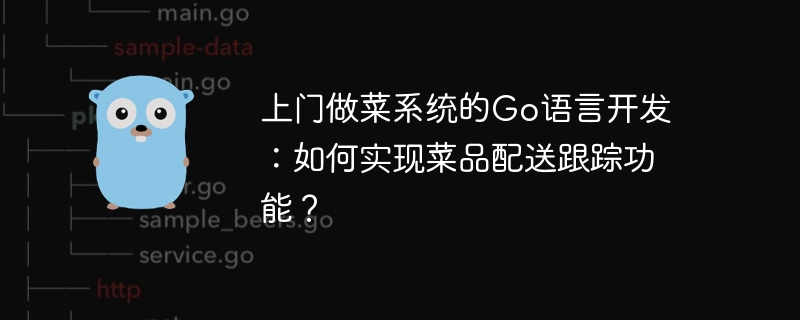Home >Backend Development >Golang >Go language development of door-to-door cooking system: How to implement the food delivery tracking function?
Go language development of door-to-door cooking system: How to implement the food delivery tracking function?
- WBOYWBOYWBOYWBOYWBOYWBOYWBOYWBOYWBOYWBOYWBOYWBOYWBOriginal
- 2023-11-01 13:43:591167browse

With the continuous improvement of people's living standards, a large number of families and individuals have begun to choose door-to-door cooking services. This service has become one of the popular products in today's market. However, how to ensure the efficiency and accuracy of food delivery has become one of the urgent problems in the industry that needs to be solved. In this article, we will discuss how to implement the food delivery tracking function in Go language and provide specific code examples.
- Project Overview
In the door-to-door cooking system, the food delivery tracking function is a very important link. How to ensure the time and safety of dishes from packaging to delivery is not only related to customer satisfaction, but also closely related to the company's reputation and market prospects. Therefore, designing and implementing an efficient and reliable food delivery tracking function has become an indispensable part of the system.
- Implementation method
In the door-to-door cooking system, we can use Go language to implement the food delivery tracking function. Go language is concurrency, scalability and efficiency, making it very suitable for developing such real-time systems.
When implementing specific functions, we can host a delivery person's information in a structure. This structure contains the delivery person's name, job number, phone number and other information. In addition, we also need to record the status of each order, including order completed, shipped, and in progress.
We can use the following code to define the structure of the delivery person:
type Deliverer struct {
Name string
Id int
Tel string
Pos Point
}
type Point struct {
X, Y float64
}In order to implement the food delivery tracking function, we need to monitor orders in real time. We can use the WebSocket protocol provided by the Go language to achieve real-time monitoring.
The WebSocket protocol can realize two-way communication between the client and the server, making it easy to realize the real-time monitoring function of the system. For each order, we can send its real-time status to the server through the WebSocket protocol, and then push these statuses to the orderer's client through the server.
We can use the following code to implement real-time monitoring of order status:
//服务端
func handleOrder(w http.ResponseWriter, r *http.Request) {
//处理WebSocket连接请求
conn, err := upgrader.Upgrade(w, r, nil)
if err != nil {
log.Println(err)
return
}
//读取订单状态
status, err := readOrderStatus()
if err != nil {
log.Println(err)
return
}
//推送订单状态
err = conn.WriteMessage(websocket.TextMessage, []byte(status))
if err != nil {
log.Println(err)
return
}
}
//客户端
func getOrderStatus() {
//建立WebSocket连接
c, _, err := websocket.DefaultDialer.Dial("ws://localhost:8080/getOrderStatus", nil)
if err != nil {
log.Fatal("dial:", err)
}
defer c.Close()
//读取订单状态更新
for {
_, message, err := c.ReadMessage()
if err != nil {
log.Println("read:", err)
return
}
log.Printf("recv: %s", message)
}
}When implementing the WebSocket protocol, we can use the third-party library gorilla/websocket, which provides a rich set of WebSocket Protocol related API.
- Conclusion
The success of the door-to-door cooking system is inseparable from the efficient and reliable food delivery tracking function. This article starts from the Go language, provides you with a feasible implementation solution, and gives specific code examples, hoping to be helpful to the majority of technical practitioners.
The above is the detailed content of Go language development of door-to-door cooking system: How to implement the food delivery tracking function?. For more information, please follow other related articles on the PHP Chinese website!
Related articles
See more- Use PHP to write Jingdong Industrial Platform API interface docking code to implement order management functions!
- PHP and XML: How to implement order management in e-commerce systems
- How to use PHP and Vue to implement the order management function of warehouse management
- Using Java to develop the order management function of the warehouse management system
- How to use PHP to develop a simple order management function

